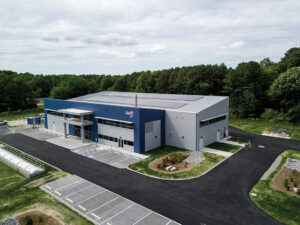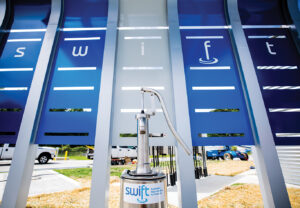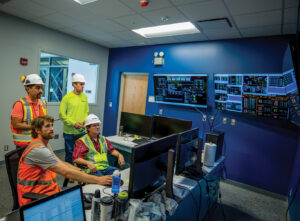H
ampton Roads Sanitation District (HRSD) is unusual in several ways. The southeastern Virginia wastewater utility is governed by an apolitical, governor-appointed commission; it covers a broad area encompassing multiple municipalities; and it bills its customers directly, all of which provide it with a certain independence and regionwide outlook. Moreover, HRSD has embarked on an ambitious aquifer recharge program. Through its Sustainable Water Initiative for Tomorrow (SWIFT) program, HRSD is putting its highly treated effluent through additional advanced water treatment processes to produce SWIFT water—water that meets drinking water standards—and using it to recharge the coastal plain aquifer, thus simultaneously reducing HRSD’s discharges into the Chesapeake Bay, replenishing the region’s groundwater supplies, and possibly slowing or reversing land subsidence.
In this interview, Ted Henifin, general manager of HRSD, tells Municipal Water Leader Managing Editor Joshua Dill about the motivations behind SWIFT, its accomplishments, and the developments he expects to see over the next 100 years of wastewater treatment.

Joshua Dill: Please tell us about your background and how you came to be in your current position.
Ted Henifin: I pursued an education in civil engineering and have
worked in the public sector in a variety of jobs for my whole career, originally in the Navy and then in local government as a public works director. I have been in the Hampton Roads area the whole time. I was aware of the regional wastewater treatment agency, HRSD, and was looking for an opportunity to contribute, so when the general manager position opened, I pursued it. I was fortunate enough to be selected in 2006, and I have been able to take advantage of the professional relationships I’ve built in the Hampton Roads area in my new job and have continued to expand them in wastewater.
Joshua Dill: Please tell us about HRSD’s services and its service area.
Ted Henifin: We are a regional wastewater treatment agency in southeastern Virginia, covering a large service area of about 3,100 square miles with a population of about 1.7 million people. About 20 percent of Virginians are our customers. We provide interceptor, transmission, and conveyance systems as well as treatment. The local governments that we serve collect the wastewater in their localities through a variety of gravity and pressure systems and then transfer it to our system at about 1,000 points of collection where they’ve got terminal pump stations. Our service area is flat coastal land, so most of our system is made up of large-diameter pressurized pipes that move wastewater to our treatment plants 
HRSD was created by a referendum and legislation that created a political subdivision in Virginia. Our eight- member commission is governor appointed, meaning that it is not directly connected to local governments. There are some residency requirements stipulating that the commissioners be drawn from across the region we serve, but they are tasked with looking out for the interests and the environment of the commonwealth as a whole, so they don’t have a parochial viewpoint. The commissioners serve at the governor’s pleasure for a 4-year term and can be reappointed. At this point, the commission is apolitical. The commissioners do not receive pay beyond a minimal stipend of $50 per meeting, so for them, it is a way to give back to the community. The commission hired me as general manager.
HRSD is singularly focused on wastewater, which in some ways makes the job easier. However, that also means that if we want to do integrated water management work, we have to develop relationships, because some of what we want to work on falls outside the scope of our authority. We bill our customers directly. Our customer base pays their local governments for sewer collection and maintenance services and then pays us for wastewater treatment. The 1.7 million people in our service area hold 470,000 individual accounts, which are billed based on water consumption. We send accountholders a bill on a regular basis, depending on how frequently their local government reads the water meter
All this sets us apart from most other agencies. We are a truly regional agency with a governor-appointed, apolitical board, and we bill our customers directly to raise our revenues. Those are advantages over most wastewater agencies.
Joshua Dill: Please tell us about HRSD’s SWIFT program.
Ted Henifin: Around 2014, we were doing some long-term scenario planning as an organization, trying to envision the situation of wastewater in our region in 50–100 years. The thing that consistently came up in all our scenarios was the lack of regulatory stability. We knew that regulations on wastewater discharge would continue to change and that we would continue to need to make major periodic investments in our treatment plants to keep up. That process led us to ask how we could get some control over our future. We came up with the idea that treating our wastewater to drinking water standards would be one way to do this because there’s not much more a regulator could ask us to do. That, in turn, led us to look into whether that kind of treatment was feasible, and what we could do with the valuable purified water that would result. Around the same time, the State of Virginia was looking at cutting back on some of the major groundwater withdrawal permits because its modeling was showing
 that the aquifer was being depleted more rapidly than it could be naturally recharged. We realized that if we had drinking-quality water, we could put it back in the aquifer and possibly help remedy the aquifer depletion problem. We did some modeling in 2015 using the groundwater model the state had developed and found that recharging the aquifer from our treatment plants actually would make a positive difference over the 50-year period we were considering.
that the aquifer was being depleted more rapidly than it could be naturally recharged. We realized that if we had drinking-quality water, we could put it back in the aquifer and possibly help remedy the aquifer depletion problem. We did some modeling in 2015 using the groundwater model the state had developed and found that recharging the aquifer from our treatment plants actually would make a positive difference over the 50-year period we were considering.
Not all our plants are located near the ocean, where they could discharge brine, so we were interested in finding something other than membrane technology, which creates a brine-laden discharge. We piloted a membrane- based treatment train based on the California standard of microfiltration and reverse osmosis. We installed that side by side with a carbon-based process: traditional flocculation/sedimentation followed by biologically activated carbon and granular-activated carbon polishing and UV. We ran the pilot for 6–7 months in 2016 and found that both of the processes could reliably meet drinking water standards. The big difference was that the carbon- based process doesn’t remove salts. The carbon-train effluent was above the secondary maximum contamination level for total dissolved solids (TDS), though its TDS was still well below that of the groundwater.The SWIFT water from the carbon-based process averaged 600–700 milligrams per liter (mg/L). Groundwater in our region ranges from 700 to well over 1,500 mg/L. The TDS in SWIFT water actually made the water more compatible with groundwater. We’ve selected the carbon- based process. The next step was to make enough of this water to start putting it in the ground and to see if it would make a difference. We built a research and public education facility in Suffolk, where we produce 1 million gallons a day and have been successfully putting that in the ground for a number of months.
We still discharge 150 million gallons a day into the Chesapeake Bay on average, adding up to hundreds of thousands of pounds of phosphorous and millions of pounds of nitrogen annually. If we can divert that water and put it back in the ground, where the nitrogen and phosphorous levels are higher than in the SWIFT water, we can improve the quality of the water in the bay and help the region to comply with its total maximum daily load.
The other thing we found along the way was that because of withdrawals from the aquifer, there has been some land subsidence. The U.S. Geological Survey (USGS) has measured about 4 millimeters per year of land subsidence because of excessive groundwater withdrawals. If we can put water back into the aquifer and increase its pressure, we might get some of that back. Our models have shown that to be the case. USGS monitors aquifer compaction near our recharge well, and it is seeing a response at this point, although we don’t have all the data cleaned up yet.
The big benefits are regulatory stability, the reduction of discharge into Chesapeake Bay, sustainable groundwater supply from our aquifer in eastern Virginia, and the potential to address some of the effects of aquifer compaction.
Joshua Dill: What will the aquifer recharge program look like when it is fully developed?
Ted Henifin: The research facility we’ve got today has a capacity of 1 million gallons a day. For our full-scale project, we will build out facilities at five of our treatment plants, treating a total of 100 million gallons a day by 2030. The
first one will come online sometime around 2023, and pretty much every other year from then until 2030 we’ll be bringing much larger full-scale facilities online. Our treatment plants have a combined capacity of about 250 million gallons a day. Our largest plant is too close to the coast to use as a recharge site, and several of the smaller treatment plants are too small to cost effectively add the advanced treatment facilities required for SWIFT. We are building these advanced water treatment facilities at the end of the rest of our regular water treatment facilities. We’re designing them to take the average day flows, so they will be used close to 100 percent of the time. That capacity is smaller than the full design rating of the treatment plants, so during wet weather and periods of peak flow, we’ll still be discharging fully treated secondary effluent through our outfalls, but the majority of the flow will be routed to the advanced treatment facilities to be treated to meet drinking water standards and used to recharge the aquifer.
Joshua Dill: When you were considering this project, were you inspired by aquifer recharge projects in other parts of the country?
Ted Henifin: Absolutely. We visited Orange County, which is probably the gold standard for aquifer recharge. That helped us understand the benefits as well as the challenges of aquifer recharge. We did research on where else it’s been done around the world and for how long. Recharge actually has a pretty lengthy successful history, typically in arid regions suffering from water scarcity. We are not a water- starved region from a surface water standpoint, but we are depleting our groundwater faster than nature can replenish it.
For us, it was a priority to do this without high-energy-use membrane technology that would create a significant brine flow. The nice thing about the carbon process is that pretty much 100 percent of that water goes through the process, less some backwash that goes back into our treatment plant. The other big benefit is that it doesn’t create a concentrate that is heavily laden with brine or other byproducts that have to be treated before being discharged back into the environment.
Joshua Dill: What is the source of the drinking water in your service area?
Ted Henifin: About 80 percent is surface water, most of which comes from the western parts of our service area. On the Virginia Peninsula, in the northern part of our service area, there are a series of reservoirs that bring water down from various surface catchments to the west. On the south side of our service area, we have some surface water catchment reservoirs. There is also a 74-mile-long, 60-inch-diameter pipeline from Lake Gaston in North Carolina that brings water to our region. That was completed in 1997, amid a lot of controversy.
The other 20 percent of the supply is groundwater drawn from municipal groundwater wells. All our municipal water supplies have wells for drought-resistance strategies and backup supplies. Our region has not experienced a major drought in more than a decade, so it becomes easy to overlook the fact that a prolonged drought would affect our surface water sources. SWIFT provides added resilience to our region’s water supply.
Joshua Dill: So to a certain extent this could be considered an indirect potable reuse project.
Ted Henifin: Correct. Actually, there is already an indirect potable reuse project in the Upper Occoquan system in northern Virginia. The Upper Occoquan Service Authority has been discharging successfully into the Occoquan Reservoir for more than 40 years. That means that there is some familiarity with and acceptance of indirect potable reuse within Virgina already.
Joshua Dill: What is the public opinion about your aquifer recharge program?
Ted Henifin: We’ve done some outreach work, including focus groups, surveys, and in-depth interviews. Opinion
has been pretty positive, maybe because the majority of the region’s water is not drawn from the aquifer. I also think
that the world, the country, and the region are much more accepting of the idea that there is a limited supply of fresh water on the planet, and that as we continue to grow and climate change continues to affect us, we need to be better stewards of water. I think there is a general acceptance that the technology can make it happen and is safe. We’ve held a number of water tasting events, and the majority of the people there will taste the water and don’t seem to have any problem with it.
We also have the benefit of having NASA’s Langley Research Center, one of the oldest NASA research centers, in Hampton. That is where they trained the Mercury, Gemini, and Apollo astronauts for many of their missions. That means we’ve got a science-based population that understands that space exploration requires the use of reclaimed water. I think there’s a general acceptance that this is a good idea if done properly.
Joshua Dill: Could this program be replicated elsewhere on the East Coast, and how do factors like geography and geology affect this?
Ted Henifin: The aquifer we’re dealing with is part of a coastal plain aquifer that goes along the Atlantic coast from New Jersey to South Carolina. There are lots of opportunities along this coast. I know that some communities around Annapolis, Maryland, are looking at what we’re doing to see if they could do something similar. Some folks from South Carolina have talked to us as well.
One geographic factor that works to our advantage is that we are the water users farthest downstream. Water users who are farther inland and who discharge into a smaller river where the flow is needed by downstream users can’t necessarily use their water to recharge the aquifer without reducing that flow. Our solution can’t be applied everywhere. Even in Virginia, once you get west of the fall line, you couldn’t do this kind of aquifer recharge project.
Joshua Dill: Would you tell us about your vision for the future for HRSD and SWIFT?
Ted Henifin: We see SWIFT as the future of wastewater treatment, providing a holistic view of water. Our goal is
to complete the initial rollout, ending in 2030, to prove the concept and to show that we can do this on a large scale.
Over time, I think we will need to do some sea level rise adaptation work. Even if we are successful in slowing down aquifer compaction, the sea is still rising. We will need to do some climate change–related work in the 2030–2050 range.
I think that we’ll come back around to the idea of expanding SWIFT from average day flows to become zero-discharge plants sometime during this century. That will be the next big thing for us until such time as we can help the industry find a better way to deal with waste altogether. The concept of using clean water to move waste through large pipes for miles and miles to centralized treatment plants is not sustainable. I hope that within 100 years we will have a better way of dealing with waste at the source or through small, distributed systems.
Ted Henifin is the general manager of the Hampton Roads Sanitation District. He can be contacted at ehenifin@hrsd.com.
